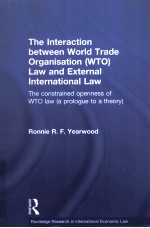图书介绍
THE INTERACTION BETWEEN WORLD TRADE ORGANISATION(WTO)LAW AND EXTERNAL INTERNATIONAL LAWPDF|Epub|txt|kindle电子书版本网盘下载

- RONNIE R.F.YEARWOOD 著
- 出版社: ROUTLEDGE
- ISBN:0415565162
- 出版时间:2012
- 标注页数:240页
- 文件大小:64MB
- 文件页数:263页
- 主题词:
PDF下载
下载说明
THE INTERACTION BETWEEN WORLD TRADE ORGANISATION(WTO)LAW AND EXTERNAL INTERNATIONAL LAWPDF格式电子书版下载
下载的文件为RAR压缩包。需要使用解压软件进行解压得到PDF格式图书。建议使用BT下载工具Free Download Manager进行下载,简称FDM(免费,没有广告,支持多平台)。本站资源全部打包为BT种子。所以需要使用专业的BT下载软件进行下载。如BitComet qBittorrent uTorrent等BT下载工具。迅雷目前由于本站不是热门资源。不推荐使用!后期资源热门了。安装了迅雷也可以迅雷进行下载!
(文件页数 要大于 标注页数,上中下等多册电子书除外)
注意:本站所有压缩包均有解压码: 点击下载压缩包解压工具
图书目录
Prologue1
0.1 Thie tragedy ofchoice: to write is to chioose1
0.2 Thiere is no magic but in the pretence7
0.3 Outliiie of my approach8
0.4 Outline of my argument19
0.5 Mr. Paloinar, Sisyphus and Alice22
1 Introduction: the fragmented nature of international law26
1.0 Introduction26
1.1 Definitional sketch of fragmentation28
1.2 Rational reconstruction34
1.3 The rule of recognition36
1.3.1 Tlhe internal point of view37
1.3.2 Hart’s circularity40
1.3.3 Dworkin’s challenge to Hart43
1.4 The coumter -factual rule of recognition: the beginnings of a theory of WTO law45
1.5 Conclusion53
2 The inadequacy of the professional tool box of treaty interpretation as an account of fragmentation55
2.0 Introduction55
2.1 Lex specialis as an account of fragmentation nd WTO law55
2.1.1 The problems with lex specialis as an account of fragmentation57
2.2 Lex posterior as an account of fragmnentation and WTO law58
2.2.1 The problems of lex posterior as an account of fragmentation: the example of WTO law and the Convention for International Trade in Endangered Species60
2.3 Treaty inter pretation as an account of fragmentation and WTO law61
2.3.1 The problems with the Vienna Convention on the Law of Treaties Articles 31 and 32 as an account of fragmentation64
2.4. The interpretative approaches of the WTO adjudicating bodies67
2.4.1 The example of EC— Biotech69
2.5 Conclusion74
3 The constrained openness of WTO law75
3.0 Introduction75
3.1 Thte continntation of building a theory of WTO law76
3.2 The internal point of view ofthe WTO adjudicating bodies80
3.2.1 The (re)construction of external international law into WTO law85
3.2.2 The Petersmann-Alston debate89
3.3 Fragmentation reconsidered92
3.4 Indirectly and strategically influencing WTO law95
3.5 Conclusion101
4 The debate on the interaction between WTO law and external international law103
4.0 Introduction103
4.1 Model Ⅰ: WTO law as a limited domain104
4.2 Model Ⅱ: WTO law as open105
4.3 Model Ⅲ: WTO lae as privileged106
4.4 The structural nature of the debate107
4.5 Resolution ofconfict by superficial means109
4.5.1 Modcls I and I1 on the purpose ofArticles 3.2 and 19.2110
4.5.2 The distinction between jurisdiction and applicable law111
4.5.3 Illustrating the debate113
4.6 The constrained openness of WTO law: identifying the purpose of WTO law114
4.6.1 Distilling the features of a theory: mapping constrained openness through Calvino’s Invisible Cities123
4.7 Conclusion126
5 The Precautionary principle and the WTO Agreement on Sanitary and Phytosanitary Measures128
5.0 Introduction128
5.1 The precautionary principle129
5.2 The gateway approach for the in corporatiorn of the precautionary principle into WTO law132
5.3 Overview of the SPS Agreerrment133
5.3.1 Compliance with WTO/GATT is not necessarily an SPS defence135
5.3.2 The ‘right’ to take an SPS measure137
5.3.3 Definition and coverage of an SPS measure138
5.3.4 Harmonisation of international standards and the SPS Agreement141
5.3.5 The scientific requirements of the SPS Agreement142
5.4 The precautionary principle and the texts of the SPS Agreemenl145
5.5 The (re)construction of precaution as a variable in the practice of WTO law148
5.5.1 EC- Hormones and initial thoughts on (re)construction of external international law148
5.5.2 The scientific requirement to maintain an SPS measure151
5.5.3 The two different definitions and evidentiary standards of risk assessment154
5.5.4 The scientific risk assessment requirement ofArticle 5.1 and its relationship to Articlc 5.5156
5.5.5 Insufficient evidence, showing uncertainty and the provisional SPS measure of Article 5.7158
5.5.6 The right of a Member to set a higher level of SPS protection, standard of review and Article 3.3162
5.5.7 Returning to EC - Horniones: (re)constructing precaution into a trade law variable167
5.6 Rethinking the incorporation of the precautionary principle in WTO law172
5.7 Conclusion174
6 Examples of interaction between WTO law and external international law175
6.0 Introduction175
6.1 A bilateral agreenment: EC - Poultry176
6.1.1 Case commentary: EC-Poultry180
6.1.2 Case analysis: EC-Poultry182
6.1.3 Summary: EC-Poultry184
6.2 An agreement between a WTO Member and an international organisation: Argentina -Textiles and Apparels185
6.2.1 Case commentary: Argentina - Textiles and Apparels188
6.2.2 Case analysis: Argentina - Textiles and Apparels189
6.2.3 Summary: Argentina- Textiles and Apparels190
6.3 Law ‘nnot contracted out fron’: Korea - Government Procurement191
6.3.1 Case commentary: Korea - Government Procurement192
6.3.2 Case analysis and summary: Korea -Government Procurement194
6.4 International environmental law to define WTO law: US - Shrimp194
6.4.1 Case commentary: US -Shrimp196
4.2 Summary: US-Shrimp199
6.5 Potential cross conflict with another trade law system (North American Free Trade Area (NAFTA)): Mexico- Soft Drinks199
6.5.1 Case commentary: Mexico -Soft Drinks204
6.5.2 Case analysis: reflexive law and developing strategies for influencing WTO law205
6.6 Conclusion209
7 Conclusion211
Selected bibliography219
Index234